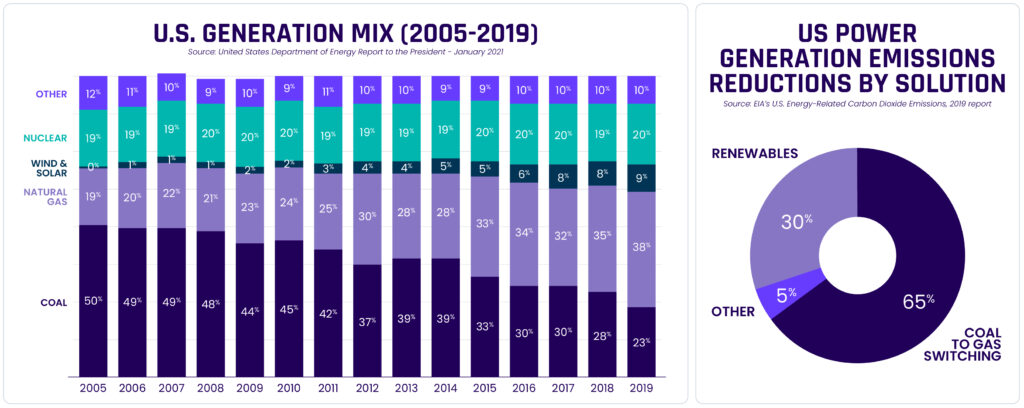The U.S. has been a global leader in lowering its greenhouse gas emissions for the past two decades. According to the EPA, U.S. greenhouse gas (GHG) emissions in 2021 were 17 percent below the 2005 level. While this statistic represents a remarkable national achievement, the factors that drove this historic reduction are poorly understood.
Many people mistakenly believe that the rapid growth of renewable energy sources - a noteworthy success story in its own right - is responsible for the decline in emissions. However, while renewables played an important role, we must recognize that the sheer scale of this decrease would not have been possible without natural gas.
While critics of natural gas defer to renewables as the only viable emissions solution, the truth is that the current state of battery storage and transmission infrastructure poses real obstacles to the buildout of renewables. Meanwhile, more power is generated globally with coal than any other fuel source. This persistence of coal, and its resulting emissions, will only continue if we adopt a renewables-or-bust approach.
But we can drastically slash emissions right now if we replace the dirtiest coal-fired power plants worldwide with natural gas. Gas burns far cleaner than coal and is more reliable than renewables, making it the best option to simultaneously achieve energy security, reliability, and emissions reductions. In fact, global power sector emissions would be reduced by 30% if the world’s top 5% worst emitting power plants switched to natural gas. Those emissions savings would increase to nearly 50% if that switch incorporated carbon capture and storage.

Natural Gas Was The Primary Driver to Lowering Emissions
The fact is that natural gas has been the key to lowering overall emissions in the U.S. since 2005. In total, 65% of all U.S. power generation emissions reductions from 2005-2019 were driven by switching from coal to gas. By contrast, renewables only accounted for roughly 30% during this period.
Energy Secretary Jennifer Granholm said natural gas “can play an important role as part of the clean energy transition” and that “pipeline and transmission capacity is critical to maintaining energy reliability, availability, and security.
Natural gas's reliability, availability, and low-carbon footprint have made it the ideal replacement for much dirtier coal as our underlying baseload fuel source. That is because natural gas is a very efficient energy source, producing the same power as coal while emitting 50% less CO2.
Our expanding use of natural gas has advanced our clean energy goals and is helping ensure we can provide a stable and secure energy supply to the American people. This understanding led the U.S. Department of Energy to say in 2021 that "natural gas, which is quickly dispatchable, provides reliable, baseload power, serving as an important partner in continued renewable energy expansion."
Global Emissions Remain Stubbornly High
Unfortunately, the rest of the world is lagging in the energy transition. Due to global supply constraints and geopolitical instability, other large countries are failing to give up coal and reap the emissions reductions of natural gas. As a result, global coal consumption reached an all-time high in 2022.
While we have the model to reduce emissions, we need to adopt policies that allow us to lead the clean energy transition and bring this solution to the rest of the world. Without a plan to shift the world's energy away from coal, our contributions at home will fail to make a dent in a global crisis.

